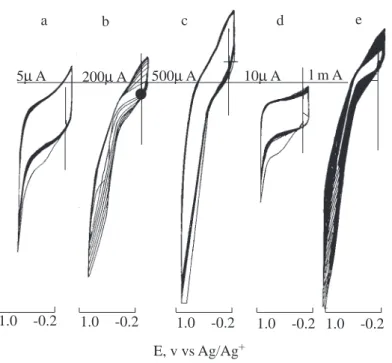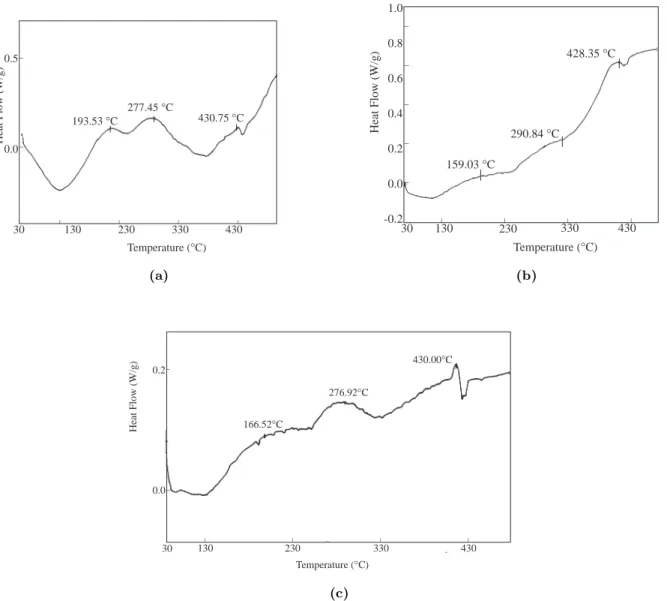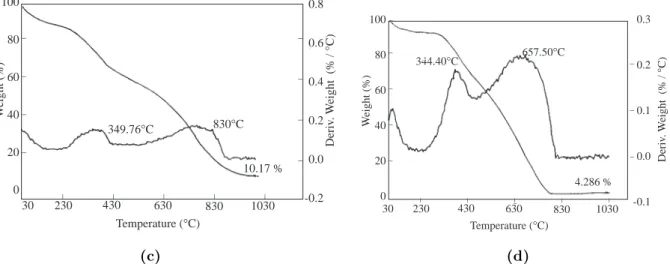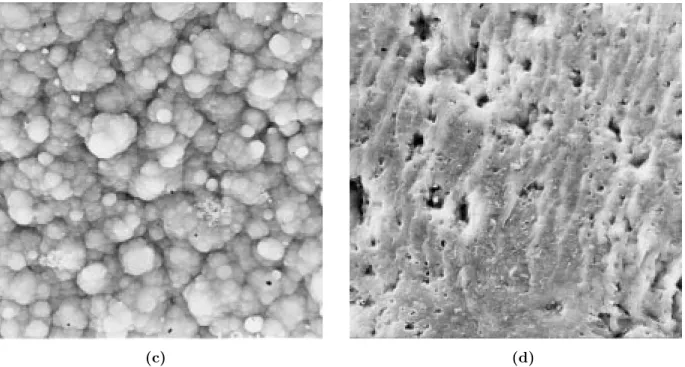c
T ¨UB˙ITAK
Electrically Conductive Polymer Grafts Prepared by
Electrochemical Polymerization of Pyrrole onto
Poly[(methyl methacrylate)-co-(2-(N-pyrrolyl) Ethyl
Methacrylate)] Electrodes
Nuran BALCI, Ural AKBULUTDepartment of Chemistry Middle East Technical University
06531 Ankara - TURKEY Levent TOPPARE∗ Department of Chemistry
Bilkent University 06533 Ankara - TURKEY
Dietmar STANKE, Manfred L. HALLENSLEBEN Institute f¨ur Makromolekulare Chemie
¨
Universitaet Hannover
Am Kleinen Felde 30 D-30167, Hannover - GERMANY
Received 04.11.1997
Pyrrole was grafted on poly[(methyl methacrylate)-co-(2-(N-pyrrolyl) ethyl methacrylate)] (PMMA-co-PEMA) using constant potential electrolyses. The thermal stability of PMMA-co-PEMA was im-proved as a result of electrochemical grafting with pyrrole. The electrochemical behavior of the films was studied by cyclic voltammetry. Pyrrole was found to be electroactive on PMMA-co-PEMA electrodes.
Introduction
Electrically conductive polymers have been the subject of a considerable amount of research because of their interesting and useful electronic, optical and redox properties1. Some of these materials have high
conductivities with environmental stability. But many of these conjugated polymers are insoluble and difficult to process. Many studies have been conducted for the improvement of their processability by preparing composites2−5, and by blending6−8 the conducting polymers with thermoplastic polymers. Stanke
et.al. comparatively studied two synthetic ways to synthesize copolymers of methyl methacrylate (MMA) with 2-(N-pyrrolyl) ethyl methacrylate with pyrrole containing side groups9. MMA and 2- bromo ethyl
methacrylate (BEMA) were copolymerized and a pyrrole moiety was introduced into the copolymer by using polymer analogous reaction10. It has also been demonstrated that grafting between pyrrole and
PMMA-PEMA-7 can be achieved via oxidative polymerization of pyrrole with FeCl3 in nitromethane11. This
copolymer had also been self-crosslinked via oxidative polymerization with FeCl3 in nitromethane12. An
increase in the glass transition temperature of the final product was observed due to crosslinking between pendant prrrole groups. Hallensleben et.al. copolymerized 2-(2-Thienyl) ethyl methacrylate (2-TEMA) with methyl methacrylate (MMA) and grafted thiophene onto co-2TEMA, co-3TEMA, PMMA-co-PEMA oxidatively13.
In this paper, we present the synthesis and characterization of electrochemical grafting of polypyrrole on PMMA-co-PEMA (copolymers containing 7% and 0.7% PEMA) using sodium p-toluene sulfonate as the supporting electrolyte in aqueous media.
Experimental
Materials
PMMA-PEMA copolymers were synthesized as described earlier13. Pyrrole (Merck) and acetonitrile (AN) (Merck) were used as received. Sodium p-toluene sulphonate was prepared by titrating p-toluene sulfonic acid monohydrate (Aldrich) with sodium hydroxide.
Synthesis of the Graft Films
PPy/co-PEMA grafts were prepared by electrochemical polymerization of pyrrole onto a PMMA-co-PEMA-coated electrode at a constant potential of 0.8 V versus Ag0/Ag+(10−2M) at room temperature
under nitrogen atmosphere. The working and the counter electrodes were 1.5-cm2 platinum foils, and the
reference electrode was a Ag0/Ag+ luggin capillary. The solvent-electrolyte couple was water (with 16%
(v/v) acetonitrile)-sodium p-toluene sulphonate. Pyrrole and electrolyte concentrations were 0.05 M and 0.09 M, respectively. PMMA-co-PEMA (7% PEMA) and PMMA-co-PEMA (0.7% PEMA) were dissolved in acetonitrile and coated onto platinum electrodes by dipping the electrode in the polymer solution and allowing the solvent to evaporate. The coated electrode was then placed into the cell containing aqueous pyrrole solution with sodium p-toluene sulphonate, and electrolyses were carried out. After the polymerization, the films were washed with water and acetonitrile, and dried. Blank runs in the absence pyrrole were also done for both pristine copolymers to check their stability under electrolysis conditions.
Measurements
Differential scanning calorimetry (DSC) and thermal gravimetric analysis (TGA) studies were recorded on a Du Pont 2000 instrument. Scanning electron microscope (SEM) (JSM-6400) was used to observe the surface morphology of the films. Conductivities of the samples were measured by four-probe technique. Cyclic voltammetry was used in order to study electroactivities of the monomer and polymers. The multiscan voltammograms of the copolymers were recorded on potential range -0.2 to +1.0 V in 0.09 M electrolyte. Accordingly similar runs were repeated in the presence of 0.0036 M pyrrole solution.
Results and Discussion
Free standing black films were easily peeled off of the electrode surface. When these films were washed with the solvent of pristine copolymer (acetonitrile) for 3 days and dried, only 10% of the PPy/PMMA-co-PEMA.7 and 6% of the PPy/PMMA-co-PEMA.0.7 films were lost by weight. We believe the remaining insulating polymers were incorporated through the growing pyrrole chain. In cyclic voltammetry studies both PMMA-co-PEMA.7- and PMMA-co-PEMA.0.7-coated electrodes indicated electroactivity only in the first cycle (Figures 1a and d). However, this electroactivity was absent in successive runs. This may well mean that the possibility of self crosslinking through electrochemical coupling in the absence of pyrrole is unlikely. On the other hand, when pyrrole was added to solution, PMMA-co-PEMA coated electrodes revealed increasing electroactivity with the reaction time (Figures 1b and e), the cyclic voltammograms exhibited pyrrole-like behavior with further scans.
a b c d e
5µ A 200µ A 500µ A 10µ A l m A
1.0 -0.2 1.0 -0.2 1.0 -0.2 1.0 -0.2 1.0 -0.2
E, v vs Ag/Ag+
Figure 1. Cyclic voltammograms of (a) PMMA-co-PEMA-7, (b) PPy/PMMA-co-PEMA-7, (c) polypyrrole, (d)
PMMA-co-PEMA-0.7, (e) PPy/PMMA-co-PEMA-0.7
The glass transition temperature (Tg) of PMMA-co-PEMA.7 is 122◦C and the melting point (Tm) is 370◦C12. Tg and Tm values for PMMA-co-PEMA.0.7 are 132◦C and 367◦C11. The graft films
(PPy/PMMA-co-PEMA) of each copolymer have transitions around 160◦C, 280◦C, and 430◦C, and no decomposition was observed (Fig. 2).
In thermal gravimetry analyses of the PMMA-co-PEMA.7 and PMMA-co-PEMA.0.7, the first deriva-tive of the main weight loss is around 400◦C. However, for the p-TS− doped graft films there exist 10% and 4% remnants even at 1030◦C (Figures 3c and d). PPy/PMMA-co-PEMA.7 lost 35% at 349◦C and 55% at around 830◦C. While the grafts show double weight loss patterns, the simple mechanical mixtures of PPy and PMMA-co-PEMA have single weight loss patterns with 28% residue at 1030◦C (Figures 3a and b)
Heat Flow (W/g) 159.03 °C _ _ _ _ 30 130 230 330 430 Temperature (°C) 290.84 °C 428.35 °C _ _ _ _ _ 1.0 0.8 0.6 0.4 0.2 0.0 -0.2 _ _ 0.5 0.0 Heat Flow (W/g) 193.53 °C 277.45 °C 430.75 °C _ _ _ _ 30 130 230 330 430 Temperature (°C) (a) (b) _ _ 0.2 0.0 Heat Flow (W/g) 166.52°C 276.92°C 430.00°C _ _ _ _ 30 130 230 330 430 Temperature (°C) (c)
Figure 2. DSC thermograms of (a) polypyrrole, (b) PPy/PMMA-co-PEMA-0.7, (c) PPy/PMMA-co-PEMA-7
73.99°C 369.92°C 28.57 % 0.5 0.4 0.3 0.2 0.1 0.0 _ _ _ _ 100 80 60 40 20 0 _ _ _ _ W eight (%) _ _ _ _ _ 30 230 430 630 830 1030 Temperature (°C) Deriv . W eight (% / ° C) 100 80 60 40 20 0 _ _ _ _ W eight (%) _ _ _ _ _ 30 230 430 630 830 1030 Temperature (°C) 394.96°C 28.10 % _ _ _ Deriv . W eight (% / ° C) 0.8 0.6 0.4 0.2 0.0 (a) (b)
349.76°C 830°C 10.17 % 0.8 0.6 0.4 0.2 0.0 -0.2 _ _ _ _ 100 80 60 40 20 0 _ _ _ _ W eight (%) _ _ _ _ _ 30 230 430 630 830 1030 Temperature (°C) Deriv . W eight (% / ° C) 100 80 60 40 20 0 _ _ _ _ W eight (%) _ _ _ _ _ 30 230 430 630 830 1030 Temperature (°C) 344.40°C 4.286 % _ _ _ Deriv . W eight (% / ° C) 0.3 0.2 0.1 0.0 -0.1 657.50°C (c) (d)
Figure 3. Thermal gravimetric analyses of (a) mechanical mixture of PPy and PMMA-co-PEMA-7, (b) mechanical
mixture of PPy and PMMA-co-PEMA-0.7, (c) PPy/PMMA-co-PEMA-7, (d) PPy/PMMA-co-PEMA-0.7.
SEM photographs indicated the films to have very homogeneous surfaces, and similar appearances were obtained for washed and unwashed films (Figures 4 and 5). Solution sides of the films have regular spherical morphologies.
Conductivities of the p-TS− doped graft films were around 1.0 S/cm, which is very close to that of PPy synthesized under same conditions. There is no difference between the conductivities of PPy/PMMA-co-PEMA-7 and PPy/PMMA-co-PEMA-0.7 films.
(c) (d)
Figure 4. SEM photographs (1000 magnification) of (a) unwashed PPy/PMMA-co-PEMA-7 solution side, (b)
unwashed PPy/PMMA-co-PEMA-7 electrode size, (c) washed PPy/PMMA-co-PEMA-7 solution side, (d) washed PPy/PMMA-co-PEMA-7 electrode side.
(c) (d)
Figure 5. SEM photographs (1000 magnification) of (a) unwashed PPy/PMMA-co-PEMA-0.7 solution side, (b)
unwashed PPy/PMMA-co-PEMA-0.7 electrode size, (c) washed PPy/PMMA-co-PEMA-0.7 solution side, (d) washed PPy/PMMA-co-PEMA-0.7 electrode side.
Conclusion
Syntheses of electrically conductive polymer grafts of PPy on PMMA-co-PEMA in the presence of sodium p-toluene sulphonate as the electrolyte were achieved. Both of the copolymers (without pyrrole) indicated poorly defined electroactivities for the first runs only. However, PPy showed reversible peaks on both of the copolymer coated electrodes. The PPy/PMMA-co-PEMA films behaved more like polypyrrole as the PPy chain grew longer on the copolymer backbone. PPy/PMMA-co-PEMA.0.7 exhibited a narrower oxidation peak area than PPy/PMMA-co-PEMA.7 because of the lower concentration of pyrrole moieties on the backbone.
DSC studies of the films revealed that the thermal behaviors of the grafts were quite different than that of the pure copolymers. TGA thermograms of the mechanical mixtures and the grafts were different from each other, as indicated by different weight loss patterns. It was observed that the PPy/PMMA-co-PEMA films were thermally more stable than the pristine copolymers.
SEM studies revealed PPy to grow uniformly on PMMA-co-PEMA since the washed an unwashed electrolytic films have similar surface morphologies. This idea is further supported by conductivity mea-surements of the films. They have conductivities as high as the pure polypyrrole synthesized under same conditions.
Acknowledgements
References
1. T.A. Skotheim (Ed.) “Handbook of Conducting Polymers” Vol.l, Marcel Dekker, New York, 1986. 2. A.F. Diaz, M. Paoli and R.J. Waltman, J. Polym. Sci., Polym. Chem. Ed., 23, 1687 (1985). 3. T. Tamamura and O. Niwa, J. Chem. Soc., Chem. Commun., 375 (1987).
4. N. Balcı, L. Toppare and E. Bayramlı, Composites, 26(3), 229 (1995). 5. Y. Kang, M. Lee and S.B. Rhee, Synth. Met., 47, 157 (1992).
6. H.L. Wang, L. Toppare and J.E. Fernandez, Macromolecules, 23, 1053 (1990). 7. H.L. Wang and J.E. Fernandez, Macromolecules, 25, 6179 (1992).
8. F. Selampınar, U. Akbulut, T. Yal¸cın, S¸. S¨uzer, L. Toppare, Synth. Met., 62, 201 (1994). 9. D. Stanke, M.L. Hallensleben, L. Toppare, Macromol. Chem. Phys., 196, 75 (1995). 10. D. Stanke, M.L. Hallensleben, L. Toppare, Synth. Met., 55, 1108 (1993).
11. D. Stanke, M.L. Hallensleben, L. Toppare, Synth. Met., 72, 89 (1995).
12. D. Stanke, M.L. Hallensleben, L. Toppare, Macromol. Chem. Phys., 196, 1697 (1995). 13. M.L. Hallensleben, F. Hollwedel, D. Stanke, Macromol. Chem. Phys., 196, 3535 (1995).




